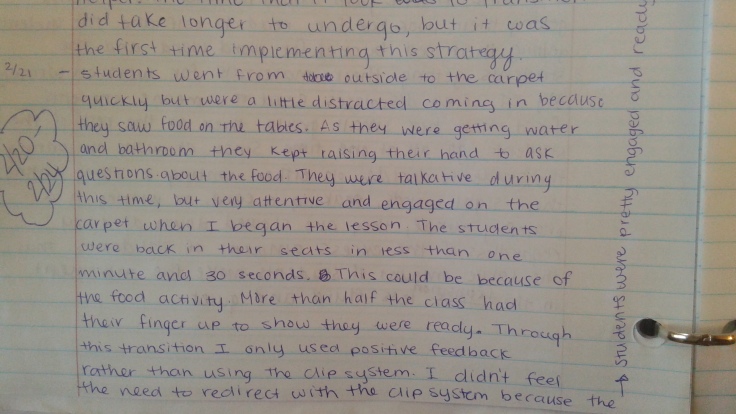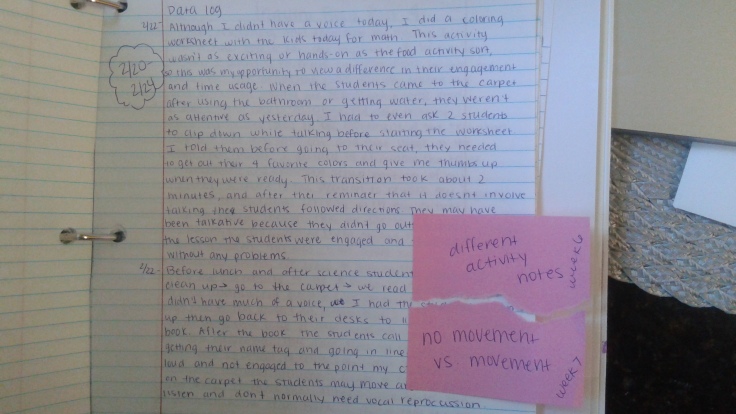My experience within my internship has allowed me to fully take over the classroom. Even though I’ve taken over, I’ve only had formal observations in math and science. Because I want to get as much feedback as possible within every aspect of my teaching ability, I chose to have my last formal observation in English Language Arts (ELA). Since the school that I’m at is an ERT school, due to the letter grade they received last year, the lessons that we teach within the classroom has to come straight from–or pretty close to–the curriculum guide given by the district. This ELA lesson was structured by the book “Red Eyes or Blue Feathers” by Patricia Stockland. This was an informational text in which was being used to reach the goal of identifying the main idea and key terms within the text by using support from the text. The text that was chosen was all about color adaptions that animals do to survive.
During my lesson there were some positives that I could take away, but I do feel as though there could have been a lot of improvements in how the information was presented and taught. Some of the things that I thought went well was the beginning portion when defining the vocabulary. From my perspective, I thought some of the terms were a little challenging for kindergarteners so I had to reword and use guiding questions to support their thinking. According to the standard for this lesson, using support and prompting questions is in line with the student outcome. For example, when defining prey I had to reword a lot to get that they are what predators hunt. Another thing I thought went well was the assessment choices I had given the students. When setting up the choices I initially thought no body would actually chose the acting out form of assessment because it was a new concept introduced to them. However, to my surprise one of my students did choose this option and preformed it flawlessly. She gave what animal she chose (red-eyed tree frog) and she then acted out the adaption while explaining her actions. To me, this showed that although I may have a preconception about my students, they know their ability and what they are good at. Even though introducing something may be challenging at first, giving students options to show their mastery is always worth it.
With every lesson, after reflection, there can always be improvements. In this lesson, I had planned on starting the lesson with a video to engage the students. The video was going to show the students how a chameleon adapts by changing color. However, unfortunately technology got the best of this aspect of my lesson because after ensuring the video worked in the morning, when I turned it on for my lesson, it was blocked. I was a little disappointed about this because I really wanted to show the students how an animal adapts in real life since adaptations is a challenging concept to understand without some sort of visual. While teaching the lesson, I saw how hard it really is to conceptualize because it’s not really a concrete topic, it’s more abstract. According to Piaget (1936), students aren’t in the developmental level to start understanding abstract material until the end of the concrete operational stage (age 7-11).
The teaching method I used in this lesson could have been better in my opinion. As I said I had to follow the curriculum guide, and I’ve noticed many times that their teaching methods are a bit dry. I did incorporate some movement opportunities in the lesson so they weren’t sitting on the carpet the whole time. When playing (or tying to play) the video the students were in their seats. Then the read-aloud took place on the carpet, and when completing their assessment they went back to their seats. This was a connection to my inquiry that I’ve been studying this year about movement transitions and their engagement. The read-aloud that I used had colorful images that kept the students entertained and intrigued. The questions that I asked throughout the book also kept the students involved and actively participating.
A student that I noticed had difficulty during the lesson was one that always likes to raise her hand when I ask questions even when she doesn’t have an answer or know the question for that matter. When I call on her and she doesn’t know the question then she takes a long time answering because she has to think about it. Thus getting the rest of the students distracted and loosing focus because of the extended wait time. The only thing I could do to solve this would be to just reword or repeat the question for her and after 10 seconds of time, tell her I would come back to her.
My next steps after this lesson would be to use a new book and focus on the same standard to see if students could take what they learned and apply it to a new book and topic. This would show me if they have mastered the concept of identifying the main idea and key ideas. I would also plan to explicitly explain to the students how to take information from the text and relate it to supporting their answers. This gives them the foundation of being able to cite text, in which they will need to know as they get older.
To explain the assessment specifically, this is where my differentiation for my variety of learners came into play. This includes students who display their knowledge better by writing, or drawing, or acting out. For ELL students who needed support with language they could have drawn a picture or acted out one of the animal adaptions. After the students were supported with their assessment choice, we all shared what we said so that we could view how each of us learned. The differentiation for the assessment gave the students 3 choices, they could either write two sentences about one of the animals and how it adapts, draw a picture and label an animal adapting to its surrounds, or write what down what animal and its adaption they were going to act out for the class. I will definitely be incorporating these options in my future classroom, because all of the students were then able to feel confident about how they displayed their knowledge.


Recent Comments